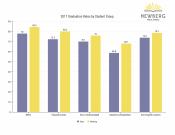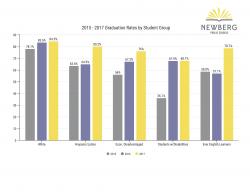More Newberg Students Graduated in 2017 Than Ever Before
Newberg’s graduation rate continues to climb, according to data released today by the Oregon Department of Education. The four-year graduation rate for all Newberg High School Students in the Class of 2017 is 83.7%, up from 79.3% in 2016, and far exceeding the state graduation rate of 76.7%. The 4.4 percentage point increase year-to-year in Newberg continues the upward trend seen over the past three years. More importantly, the graduation rate for historically underserved student populations has grown exponentially since 2015.
These increases can be attributed to many of the programs and interventions Newberg Public Schools has put into place over the past five years. The District has trained staff on teaching students who live in poverty, implemented flexible learning and credit recovery programs, launched child study teams, restructured the Catalyst program to meet the needs of more students, and grown the AVID and ASPIRE mentor programs. Increased focus on mental wellness and collective responsibility are system-wide improvements that benefit all students in grades K-12.
The improvement in graduation rates among underserved student populations is a direct result of intentional work.
“Through building an understanding of our patterns of achievement and success, we began to realize where we needed to put our energy,” explained Superintendent Dr. Kym LeBlanc-Esparza. “When we focused on our ‘All Means All’ initiative by recognizing and telling the stories of all kids, we looked at leverage points in the K-12 system that we realize have a huge weight on kids’ success.”
Chief of Staff Mikaela Schamp, who oversees dropout prevention, attributes the increase in graduation rates to the relationship-building in the District.
“It’s been the staff doing lots of work and putting lots of energy into getting students to that place,” said Schamp. “As soon as everyone understood we simply aren’t going to accept that some kids will fail and some will not, we were able to increase opportunities for kids to succeed through alternative pathways to provide credit and individualized programs.”
In addition, increased communication helped contribute to the “continuity of care” that students receive.
“Teams look at student success now, instead of psychologists, counselors, principals, and teachers working with a student and not sharing that information,” detailed Schamp. “We understand that a student might not meet the criteria for services, but still needs support.”
Students with disabilities now have nearly double the chance of graduating than they did in 2015. Special Services Director Dr. Candace Pelt believes that’s a direct correlation to improvements made in instruction and accommodation.
“We provided a lot of training on specially designed instruction and we made a big investment in assistive technology,” said Pelt. “We’ve also focused on the seamless transition after high school, which means we’re preparing students for adulthood while in high school which encourages them and changes attitudes about the value of their education.”
Newberg High School Principal Kyle Laier knows that while graduation is important, it’s what comes next that matters most.
“The increased work our educators are doing is having a positive impact on the rate, but at the same time, we continue to work to ensure that the conversation isn’t about the number of students who graduate; it’s also about ensuring that they’re prepared for college, career, and life when they leave Newberg High School,” emphasized Laier.
Newberg’s graduation rate far outpaces the state rate in all student groups.


